The classic push-up has survived the test of time and is the single most efficient exercise for strengthening the chest, arms, deltoid, and many upper body muscles.
But If you have trouble doing the basic push up, incline pushups are a good way to start.
Incline push-ups are easier than standard push-ups because they are done at an incline angle. The push will be 50% easier if you have a 45-degree incline angle with your feet below your head than if you have a horizontal angle.
The inclined surface means that incline push-ups use more of the lower chest, shoulder muscles, and triceps.
The Inline push-up is one of the greatest conditioning exercises for the outdoor athlete. It can be performed regardless of where you are, and, best of all, it is completely free—no expensive equipment or annual gym fees are required.
You only need a stable surface such as a table, desk, or wall.
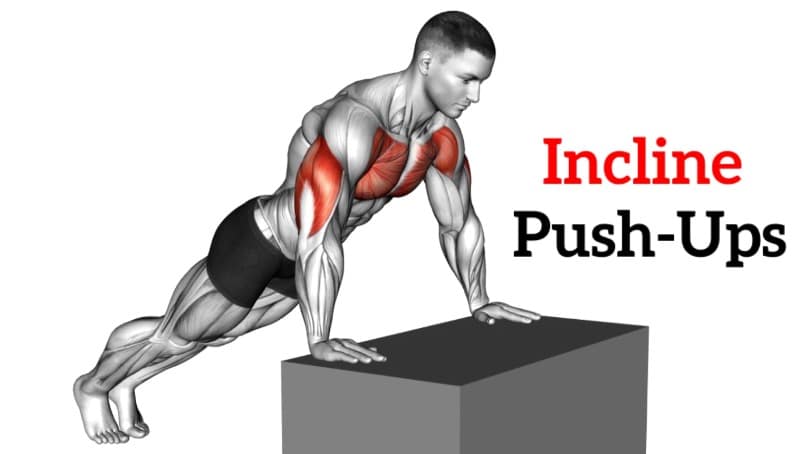
- Incline Push Up Muscles Worked
- How To Do Incline Push Up
- Form and Tips
- Incline Push-Ups Modifications and Variations
- Make Incline Push-Ups Easier
- Increase the Challenge
- 1. Wall Push Up
- 2. Incline Push-Up On Stepper
- 3. Stability Ball Push Up
- 4. Medicine Ball Push-Up
- FAQs
- Do Incline Push-Ups Work Lower Chest
- What Are Incline Push-Ups?
- When to Perform The Incline Push-Up
- Are Incline Push-ups easier
- Are Incline Push-Ups good
- What do incline push-ups work
- How many incline push-ups should I do
- Are incline push-ups easier than decline?
- References
Incline Push Up Muscles Worked
- Primary Muscles Worked: Pectoralis Major (mainly Lower Chest), Anterior deltoids (shoulder muscle), and triceps.
- Secondary Muscles Worked: lateral deltoid, serratus, trapezius, and core muscles (abs, lumbar, gluteal, pelvic, and deep spinal muscles).
- Stabilizing Muscles: Serratus Anterior, Rhomboids and Trapezius, Erector Spinae
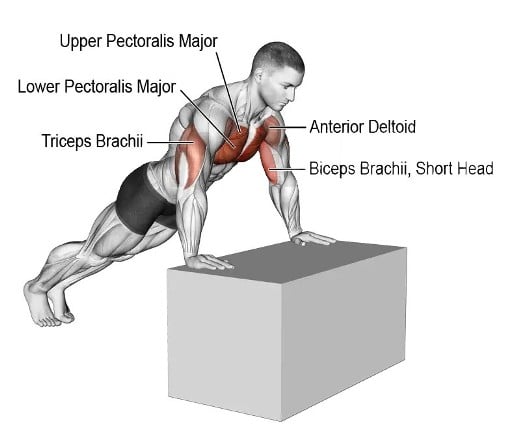
How To Do Incline Push Up
You can do this with a chair, a gym bench, a sofa, a box, a sturdy table, or anything else.
- Stand approximately 3 to 3.5 feet away from a low bench or sturdy chair. Ensure the box or bench is sturdy and won’t slide.
- Place your hands on the box shoulder-width apart, with your fingers pointing forward.
- Your palms should be flat, with fingers pointing forward or slightly turned inwards. Keep a neutral back position with your chest up and head facing forward.
- Slowly lower yourself by flexing your elbows so that your chest comes within a few inches of the edge of the chair or bench.
- Keep your elbows at about a 45-degree angle to your torso. Your chest should be directed towards the box and not your face.
- Push yourself back to the starting position while keeping your body straight from head to ankle.
- Do 3-4 sets of 10-15 reps.
Form and Tips
- If you’re just starting out, don’t hesitate to use a higher surface (like a wall). As you get stronger, gradually lower the height to challenge yourself.
- Your core is your best friend here! Engaging it throughout the movement will help support your spine and stabilize you.
- Keep your head aligned with your spine. Look slightly ahead instead of straight down to maintain a neutral neck position.
- Do not let your lower back sag or your butt rise. Ensure your body is straight and rigid.
- Perform 2–3 sets of 6–8 repetitions for the incline push-ups. As you build strength, add more reps and sets.
- Once you hit 15-20 solid reps at one height; it’s time to level down. This ensures steady, sustainable progress.
- Pay extra attention to your form and emphasize quality over quantity to improve your upper-body strength.
- Incorporate proper warm-ups, rest, and nutrition into your exercise program to see continual progress and build body strength.
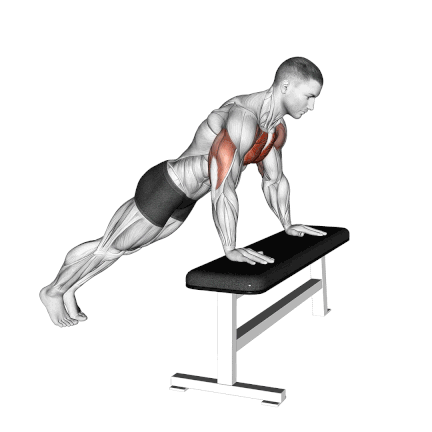
Incline Push-Ups Modifications and Variations
Push-ups are great exercises that you can modify to fit your fitness level.
Make Incline Push-Ups Easier
If you want to make incline pushups easier, place your hands on a wall or more inclined surface. Anyone can do this beginner version because you’re not lifting much of your bodyweight, and it doesn’t require as much flexibility.
Increase the Challenge
Once you’re comfortable with incline push-ups and can perform 15–20 reps with good form, consider ramping up the intensity with these variations:
- Reduce the Angle of Inclination: Lower the height of the surface you’re pushing from. Moving from a wall to a bench or a lower step will increase the challenge.
- Use a Stability and Medicine Ball: It adds instability, engaging your core muscles more effectively.
1. Wall Push Up
Incline wall push-ups are easy to do for people who are new or don’t have much strength in their upper body. Since you’re pushing against a wall, you’re lifting a smaller percentage of your body weight than other incline variations.
This variation places less strain on the shoulders and wrists than traditional push-ups or even incline push-ups on a bench.
The closer you stand to the wall, the easier it is to perform, but remember, it’s still important to be aware of your body alignment as you perform this push-up.
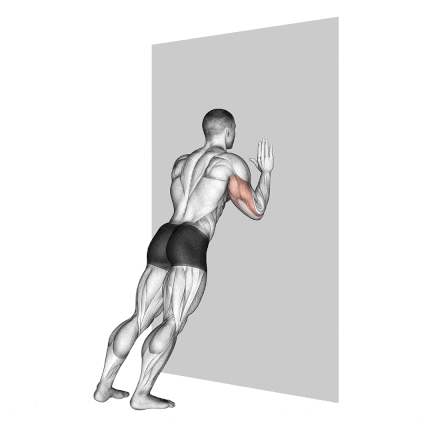
2. Incline Push-Up On Stepper
The higher you are, the easier the push-up, while the lower you are, the more challenging it is. Steppers allow for a greater range of motion than traditional push-ups on a wall or lower surface.
This increased depth may result in improved muscle activation in the chest, shoulders, and triceps.
Most steppers can be adjusted in height, so you can choose how steep they are for your fitness level. Beginners can start with a higher setting for easier push-ups, while more advanced users can lower the stepper for a more challenging angle.
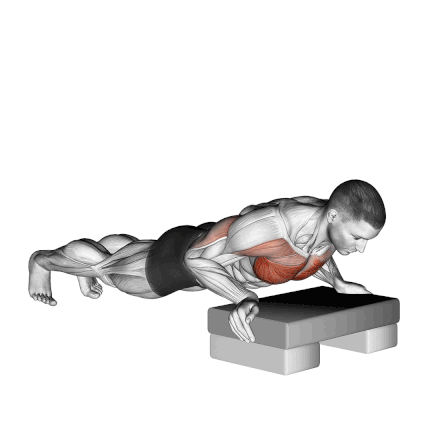
3. Stability Ball Push Up
When you push up on the stability ball, it makes them more difficult because you have an uneven surface to work with. This is an excellent exercise for working the lower part of the chest and tricep.
One of the standout benefits of stability ball push-ups is the increased activation of the core muscles. The ball’s unstable surface forces your core to engage more intensely to maintain balance and stability.
Stability ball push-ups can be easily modified to increase the difficulty level. To challenge yourself further, you can adjust the position of your feet, hands, or the ball’s placement.
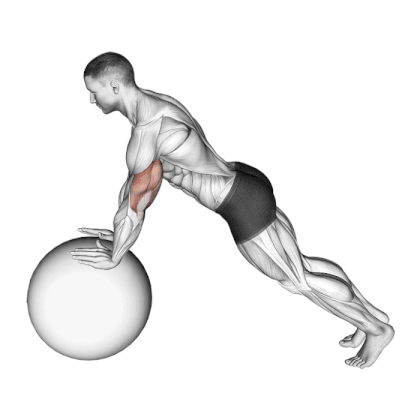
4. Medicine Ball Push-Up
Medicine ball push-ups challenge your coordination and balance as you balance your body on an uneven surface. This not only strengthens the primary muscles involved, but also enhances overall body awareness and proprioception.
Medicine ball push-ups allow for easy progression in difficulty. You can start with both hands on the ball, then progress to one hand on the ball while the other is on the floor.
For easier variation, you can do the same on knees.

FAQs
Do Incline Push-Ups Work Lower Chest
The incline push-up is one of the best pushups for the lower chest. You will be expected to incline at a certain angle to complete this move. The inclination is what helps target the lower chest muscles.
What Are Incline Push-Ups?
Incline push-ups are a bodyweight exercise that emphasizes the muscles in your lower chest. You perform them with your hands on a bench or other elevated surface. This variation of the standard push-ups reduces the amount of body weight you are lifting and allows you to practice with less strain on your arms and shoulders.
When to Perform The Incline Push-Up
These Inline push-ups are a must-have for any chest-focused workout. Because of their simplicity and lower resistance, you should do them at the end of the workout. Also, do the other push-up variations to build upper body mass and strength.
- Standard push-ups
- Decline push-ups
- Close-grip push up
- Pike Ups
- Hindu push ups
Are Incline Push-ups easier
Incline push-ups are easier than normal push-ups because of the angle at which the exercise has to be done. To make incline push-ups easier, place your hands on a wall or more inclined surface.
Are Incline Push-Ups good
Incline pushups are a good push-up variation that takes some of the pressure off of your arms and shoulders, giving you a good chest workout.
What do incline push-ups work
The incline position primarily works your lower chest muscles, but you’ll also need to engage your upper chest, shoulder, tricep and core muscles.
How many incline push-ups should I do
For incline push-ups, perform 3–4 sets of 10–20 repetitions, focusing on maintaining good technique.
Are incline push-ups easier than decline?
Incline pushups are easier than regular or decline pushups. The incline position reduces the amount of bodyweight you are lifting and puts less stress on your elbows.
It is a great way to build your chest, shoulder, and triceps and is perfect for both beginners and pros.
References
- Cogley RM, Archambault TA, Fibeger JF, Koverman MM. Comparison of muscle activation using various hand positions during the push-up exercise. Journal of strength and conditioning research. 2005 Aug 1;19(3):628.
- Freeman S, Karpowicz A, Gray J, et al. Quantifying muscle patterns and spine load during various forms of the push-up. Med Sci Sports Exerc 2006; 38: 570–577.
- Cogley R.M., Archambault T.A., Fibeger J.F., Koverman M.M., Youdas J.W., Hollman J.H. (2005) Comparison of muscle activation using various hand positions during the push-up exercise. Journal of Strength & Conditioning Research 19, 628-633.
- Borreani S, Calatayud J, Colado JC, et al. Muscle activation during push-ups performed under stable and unstable conditions. J Exerc Sci Fit 2015; 13: 94–98.
- Ebben WP, Wurm B, Vanderzanden TL, et al. Kinetic analysis of several variations of push-ups. J Strength Cond Res 2011; 25: 2891–2894.
- Suprak, David N; Dawes, Jay; Stephenson, Mark D. The Effect of Position on the Percentage of Body Mass Supported During Traditional and Modified Push-up Variants. Journal of Strength and Conditioning Research 25(2):p 497-503, February 2011. | DOI: 10.1519/JSC.0b013e3181bde2cf

Manish is a NASM-certified fitness and nutrition coach with over 10 years of experience in weight lifting and fat loss fitness coaching. He specializes in gym-based training and has a lot of knowledge about exercise, lifting technique, biomechanics, and more.
Through “Fit Life Regime,” he generously shares the insights he’s gained over a decade in the field. His goal is to equip others with the knowledge to start their own fitness journey.
